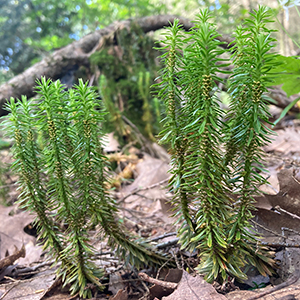Plants are well known for their ability to produce molecules that affect human cognition, including many drugs for treating neurological disease. However, we understand relatively little about how plants build these compounds, including which enzymes perform the required chemistry to synthesize them. Understanding this chemistry can help us produce plant-derived drugs more cheaply and access new molecules with useful properties.
In our new paper appearing in the journal Nature (PDF), we were interested in how plants synthesize huperzine A (HupA), a molecule that is produced by clubmosses, a family of spore-producing plants that have served as traditional medicines for hundreds of years.

Clubmosses (e.g. shown here, a clubmoss (Huperzia species), Mount Wachusett, Massachusetts) produce a diverse group of molecules called the Lycopodium alkaloids. Some of these compounds have drug-like properties and serve as candidates for treating neurological disease
HupA is known to inhibit acetylcholinesterase, an important protein in animal neural signaling, and it has been explored as a treatment for numerous neurological diseases, including Alzheimer’s dementia. Additionally, HupA contains a very distinctive chemical structure that isn’t found in most plants, which suggested to us that there may be novel chemistry involved in the production of this molecule in plants.
To understand how clubmosses synthesize HupA, we needed to identify the enzymes that build this molecule. Much like a factory assembly line, these “biosynthetic” enzymes take an initial metabolic building block and perform step-by-step chemical modifications to convert this precursor molecule into the complex structure of HupA. Importantly, we knew that HupA was only produced in a particular tissue in the clubmoss – the actively growing part of the shoot. This suggested that we should be able to locate our biosynthetic enzymes by looking at which clubmoss genes were specifically expressed in this tissue.
Using this strategy, we were able to identify several gene candidates likely involved in HupA biosynthesis. To evaluate the function of the enzymes encoded by these genes, we moved them into a model plant (Nicotiana benthamiana, a relative of tobacco) that is easier to work with in lab. This model plant allows us to test the function of enzyme candidates and determine whether they catalyze reactions within HupA biosynthesis.
Within this experimental plant system, we confirmed the function for a large number of the gene candidates, thereby demonstrating how they act together for the stepwise production of HupA. While many of the enzymes we identified carried out relatively common chemical reactions, we also found something very unexpected – a pair of carbonic anhydrase (CAH) family enzymes acted together to synthesize a key precursor to HupA.
This discovery was quite surprising to us, as CAH enzymes had previously only been known to act in the interconversion of carbonic dioxide and bicarbonate (a textbook cellular process that is critical for everything from photosynthesis in plants to dissolving CO2 in our blood). However, they had never been found to act within the biosynthesis of medicinal compounds in plants. Even more curious was that the new CAH-like (CAL) enzymes we had identified contained mutations to highly-conserved amino acids within their active site, suggesting a fundamentally different enzymatic mechanism. After finding these initial CAL enzymes, we asked a very naïve follow-up question. If some CAL enzymes are involved in the synthesis of HupA, could there be others within the clubmoss? Sure enough, we were able to identify a third CAL that catalyzed another reaction within HupA biosynthesis, and it too had mutations that suggested novel function.
Ultimately, the results of this study were exciting for several reasons. First, we uncovered a near complete biosynthetic pathway for HupA, a compound with potential as a treatment for neurological disease. By understanding this chemistry, we enable the possibility to engineer HupA production in other systems, thereby providing easier access to this molecule, or structurally-related molecules with useful medicinal properties. Additionally, by discovering the three CAL genes, we had identified an entirely new class of biosynthetic enzyme that had not previously been known to act within plant metabolism. We expect this finding will aid in future efforts to characterize how plants are able build their striking diversity of bioactive compounds. Moving forward, we are very excited about this possibility within the Nett Lab, and we are already tracking down the function of other potential CALs in clubmosses, as well as in other plants. Hopefully we will have more to report on this in the near future!
by Ryan Nett


